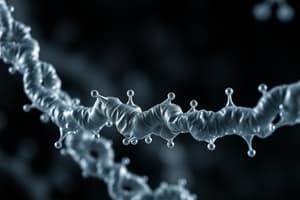Podcast
Questions and Answers
What is the main function of DNA in living organisms?
What is the main function of DNA in living organisms?
- Storing the genetic code (correct)
- Serving as an energy source
- Acting as a catalyst in cellular processes
- Regulating gene expression
Which biomolecule serves as an energy source to sustain cellular processes?
Which biomolecule serves as an energy source to sustain cellular processes?
- Proteins
- Nucleic acids
- Carbohydrates (correct)
- Lipids
What role do lipids play in the context of biomolecules interacting to create life processes?
What role do lipids play in the context of biomolecules interacting to create life processes?
- Regulating gene expression
- Storing the genetic code
- Forming the environment for protein function (correct)
- Serving as catalysts in cellular processes
Which biomolecule acts as a template for protein synthesis?
Which biomolecule acts as a template for protein synthesis?
In the context of biomolecules interacting to create life, what do proteins bind to specifically?
In the context of biomolecules interacting to create life, what do proteins bind to specifically?
What are the four principal classes of biomolecules that govern the structure, function, and behavior of cells?
What are the four principal classes of biomolecules that govern the structure, function, and behavior of cells?
Which biomolecules primarily serve as storage forms of energy and structural components of cell membranes?
Which biomolecules primarily serve as storage forms of energy and structural components of cell membranes?
What are proteins made of?
What are proteins made of?
Which biomolecule consists of saccharides and serves as essential energy sources?
Which biomolecule consists of saccharides and serves as essential energy sources?
Which biomolecule influences gene activity and can act as enzymes or transporters?
Which biomolecule influences gene activity and can act as enzymes or transporters?
Which biomolecule forms the bilayer structure in cell membranes?
Which biomolecule forms the bilayer structure in cell membranes?
Flashcards are hidden until you start studying
Study Notes
The Fabric of Life: Exploring Biomolecules
In the realm of living organisms, four principal classes of biomolecules govern the structure, function, and behavior of cells: carbohydrates, lipids, proteins, and nucleic acids. These molecules work in concert to support life's diverse processes, from energy storage and structural integrity to genetic information transfer.
Carbohydrates
Carbohydrates are composed of carbon, hydrogen, and oxygen atoms, primarily in the form of saccharides. They serve as essential energy sources and as structural components for cells and tissues. Carbohydrates are built from simple monosaccharides (glucose, fructose, and galactose), which can combine to form disaccharides (e.g., sucrose), oligosaccharides, and polysaccharides (e.g., starch and cellulose).
Lipids
Lipids are hydrophobic molecules that include fats, oils, waxes, and phospholipids. They serve as a storage form of energy and as structural components of cell membranes. Phospholipids, such as lecithin, form the bilayer that separates the interior of cells from the external environment, compartmentalizing cellular processes and creating organelles.
Proteins
Proteins are large biomolecules constructed from 20 distinct amino acids. They form the structural framework of cells, act as enzymes, transporters, and antibodies, and influence gene activity. Proteins' unique ability to fold into specific three-dimensional structures allows them to perform their diverse functions.
Nucleic Acids
Nucleic acids consist of deoxyribonucleic acid (DNA) and ribonucleic acid (RNA). DNA is responsible for storing the genetic code, which determines the amino acid sequence of proteins. RNA, in contrast, performs a variety of roles, including acting as a template for protein synthesis, regulating gene expression, and serving as a catalyst in some cellular processes.
These biomolecules do not exist in isolation but rather interact to create the magnificent symphony of life. For example, proteins bind to specific nucleic acid sequences, lipids form the environment in which proteins function, and carbohydrates serve as energy sources to sustain these processes. Understanding the intricate relationships between these biomolecules provides a deeper appreciation for the complexity of life and its underlying mechanisms.
Studying That Suits You
Use AI to generate personalized quizzes and flashcards to suit your learning preferences.




